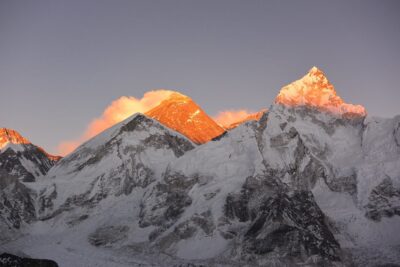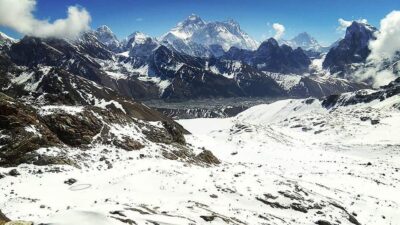Everest Base Camp is the most popular destination, attracting more than 50,000 visitors each year. Nepal experiences four distinct seasons: Spring, Summer (Monsoon), Autumn, and Winter. Each season brings its own set of advantages and challenges to the trek. Below, you’ll find the seasonal highlights and challenges of the Everest Base Camp Trek for each of these four major seasons:

Spring is one of the most popular seasons for the Everest Base Camp Trek, and for good reason. The weather is relatively mild, and the scenery is breathtaking as rhododendron forests burst into colorful blooms. Trekkers can also enjoy clear skies and stunning mountain views, including the majestic Mount Everest.
Despite its popularity, spring can bring unpredictable weather, including occasional snowfall and rain. Crowds of trekkers and climbers can lead to limited accommodation options, so it’s essential to book in advance. Trekkers should also be prepared for cooler temperatures at higher elevations and the risk of altitude sickness due to rapid ascents.

Autumn is the most favored season for the Everest Base Camp Trek. The weather is stable, with clear skies and crisp mountain views. The trails are in excellent condition, and you can immerse yourself in the vibrant Sherpa culture, as this is a time of major festivals in the region.
While autumn offers the best weather, it is also the busiest time for trekking. Accommodation can fill up quickly, and popular teahouses may become crowded. Trekkers should plan well in advance and be prepared for cooler temperatures as you ascend higher.

During the monsoon season, the Everest region transforms into lush, green landscapes with vibrant vegetation. The trails are less crowded, providing a quieter and more serene trekking experience. For flower lovers, Monsoon is undoubtedly best time as there are hundreds of different species of alpine flower blossom in the region.
Trekking during the monsoon season is generally discouraged due to heavy rainfall, which can cause landslides, muddy and slippery trails, and swollen rivers. The risk of avalanches in higher areas also increases significantly, making it a dangerous choice.

Winter offers a unique and quieter trekking experience. The landscapes are covered in snow, creating a serene and magical atmosphere. You’ll also find that teahouses are less crowded, allowing for a more intimate experience with local culture.
Winter presents extreme cold, especially at higher altitudes. Many teahouses close during this time, limiting accommodation options. Trekkers must be well-prepared for cold temperatures and snowy conditions, which can make the trails more challenging and potentially hazardous.
Remember that each season has its own charm and challenges, so choosing the right time for your Everest Base Camp Trek depends on your preferences, level of experience, and tolerance for various weather conditions. Proper planning and preparation are essential for a successful and enjoyable trek in any season.